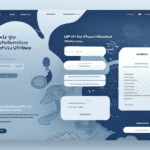Introduction to Partial Least Squares (PLS) Regression
Partial Least Squares (PLS) regression is a robust statistical technique widely utilized in data analysis for modeling complex relationships between a set of predictor variables and a response variable. Unlike traditional regression methods, PLS excels in situations with multicollinearity among predictors or when the number of predictors exceeds the number of observations.
Basics of PLS Regression
PLS regression works by projecting the predictor variables and the response variable into a new space defined by latent variables. These latent variables are linear combinations of the original predictors and are chosen to maximize the covariance between predictors and response, thereby capturing the most relevant information for prediction.
One of the key advantages of PLS regression is its ability to handle datasets with a large number of predictors, making it particularly useful in fields like chemometrics, bioinformatics, and social sciences.
Importance in Data Analysis
PLS regression is essential in scenarios where traditional regression techniques falter, such as:
- High-dimensional data with more predictors than observations.
- Data with multicollinearity issues.
- Situations requiring both prediction and exploratory analysis.
Its versatility and robustness make PLS a valuable tool for researchers and analysts aiming to derive meaningful insights from complex datasets.
Variations of PLS Regression: 1PLS to 5PLS
PLS regression has evolved into several variants, each tailored to specific types of data and analytical requirements. Understanding these variations is crucial for selecting the appropriate model for your analysis.
1PLS: Partial Least Squares Discriminant Analysis (PLS-DA)
PLS-DA is used for classification tasks where the response variable is categorical. It is particularly effective in distinguishing between two or more classes by modeling the differences in predictor variables.
2PLS: PLS2
PLS2 extends PLS1 by handling multiple response variables simultaneously. This is beneficial in studies where multiple related outcomes need to be predicted from the same set of predictors.
3PLS
3PLS introduces an additional decomposition step, allowing for more nuanced modeling of complex data structures. This variant is suitable for datasets where deeper analysis of the latent structures is required.
4PLS: Sequential Preprocessing through Partial Least Squares (SIMPLS)
SIMPLS is an alternative algorithm for PLS that simplifies the computation by sequentially processing the data blocks. It is particularly useful for large datasets with missing values, enhancing computational efficiency.
5PLS: Orthogonal Partial Least Squares (OPLS)
OPLS further refines the PLS approach by separating the predictive variation from the non-predictive (orthogonal) variation in the predictor matrix. This leads to clearer interpretation of the model by isolating the relevant information for prediction.
Choosing the Right PLS Model for Your Data
Selecting the appropriate PLS variant depends on several factors, including the nature of your response variable, the dimensionality of your data, and the specific objectives of your analysis.
Factors to Consider
- Type of Response Variable: Use PLS-DA for categorical outcomes and standard PLS for continuous responses.
- Number of Predictors: PLS2 is suitable when dealing with multiple response variables, while PLS1 is ideal for a single response variable.
- Data Structure: For hierarchical or multi-block data, consider advanced variants like multi-block PLS.
Handling Noise and Correlations
In datasets with high noise levels or strong multicollinearity, robust PLS methods such as ROBUST-PLS or sparse PLS can enhance model performance by mitigating the impact of irrelevant or correlated predictors.
Advantages and Disadvantages of PLS Regression
PLS regression offers several benefits, but it also comes with limitations that must be weighed when choosing it as an analytical tool.
Advantages
- Dimensionality Reduction: Effectively reduces the number of predictors while retaining essential information.
- Handles Multicollinearity: Deals with correlated predictor variables without the need for prior selection or elimination.
- Versatility: Applicable to both regression and classification tasks.
- Robustness: Capable of managing missing data and outliers.
Disadvantages
- Model Interpretability: The latent variables can be abstract, making it challenging to interpret the results.
- Overfitting Risk: Selecting too many latent variables can lead to overfitting, reducing the model’s generalizability.
- Computational Demand: Can be resource-intensive, especially with large datasets.
Common Misconceptions about PLS Regression
Despite its widespread use, several misconceptions about PLS regression persist, potentially leading to its misapplication.
Misconception 1: PLS is Only for Small Datasets
Contrary to belief, PLS is well-suited for large datasets with high dimensionality, often outperforming traditional regression methods in such scenarios.
Misconception 2: PLS Only Handles Linear Relationships
PLS can model both linear and nonlinear relationships by incorporating polynomial or spline functions, enhancing its flexibility in capturing complex data patterns.
Misconception 3: PLS Automatically Selects the Best Model
Proper model selection, including the number of latent variables and preprocessing steps, is essential for optimal performance. PLS does not inherently select these parameters.
Applications of PLS Regression Across Industries
PLS regression's adaptability makes it invaluable across various industries, facilitating advanced data analysis and decision-making.
Chemometrics
In chemometrics, PLS is used for spectral analysis, quantifying chemical concentrations, and quality control. It helps in interpreting complex spectral data to identify chemical compositions accurately.
Biomedicine
PLS aids in drug discovery by modeling the relationship between molecular structures and biological activities. It is also employed in biomarker identification and predicting disease outcomes.
Finance
In finance, PLS assists in portfolio optimization, risk management, and forecasting financial indicators by modeling the interplay between multiple financial variables.
Marketing
PLS is utilized for customer segmentation, product recommendation systems, and predicting customer churn, enabling businesses to tailor their strategies effectively.
Advanced Topics and Best Practices in PLS Regression
To harness the full potential of PLS regression, it is crucial to delve into advanced methodologies and adhere to best practices during implementation.
Advanced PLS Models
- Multi-block PLS: Integrates information from different data blocks, enhancing model robustness.
- Hierarchical PLS: Accounts for clustered or hierarchical data structures, improving model accuracy.
- Sparse PLS: Focuses on identifying the most relevant predictors, enhancing model interpretability.
Best Practices in Implementation
- Data Preprocessing: Ensure data is properly scaled and centered to improve model performance.
- Cross-Validation: Use cross-validation techniques to determine the optimal number of latent variables and prevent overfitting.
- Variable Selection: Implement variable selection methods to enhance model simplicity and interpretability.
Optimizing Model Performance
To maximize the efficacy of your PLS model:
- Experiment with different numbers of latent variables and use metrics like the Root Mean Square Error of Prediction (RMSEP) to evaluate performance.
- Incorporate feature selection techniques to identify and retain the most significant predictors.
- Regularly validate the model on independent datasets to ensure its generalizability.
Interpreting PLS Models
Accurate interpretation of PLS models involves:
- Analyzing the loadings and weights of latent variables to understand predictor importance.
- Assessing the R-squared and Q-squared values to evaluate model fit and predictive power.
- Visualizing scores plots to identify patterns and relationships within the data.
Conclusion
Partial Least Squares regression is a powerful and versatile tool for data analysis, capable of handling complex and high-dimensional datasets across various industries. By understanding its different variants, leveraging best practices, and applying advanced methodologies, researchers and analysts can extract meaningful insights and make informed decisions. As data continues to grow in complexity and volume, the importance of techniques like PLS regression in uncovering hidden patterns and relationships cannot be overstated.




















